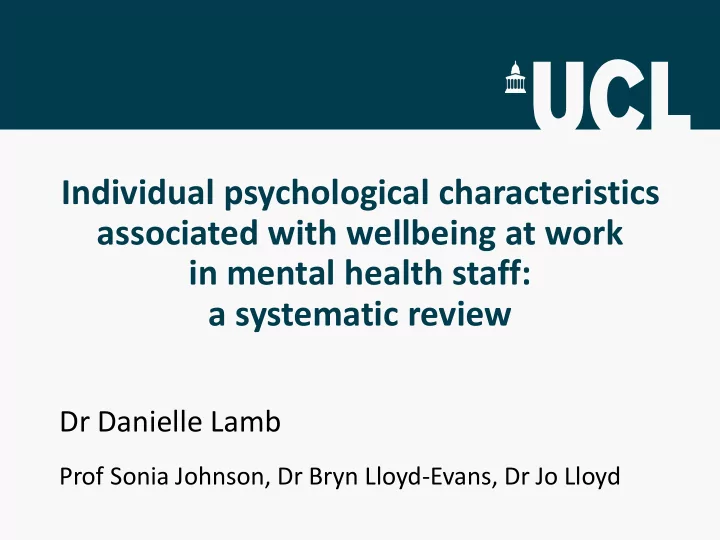

Individual psychological characteristics associated with wellbeing at work in mental health staff: a systematic review Dr Danielle Lamb Prof Sonia Johnson, Dr Bryn Lloyd-Evans, Dr Jo Lloyd
Background 1/2 Organisational factors: e.g. ++working hours, lack of control, poor remuneration – associated with higher stress and burnout (Maslach & Leiter, 2008) Individual factors: e.g. age, years of experience, gender, ethnicity – equivocal results (Keyko et al., 2016) BUT hard for individuals to change these things
Background 2/2 • Other individual differences that account for differences in wellbeing outcomes? Personality! • ‘Personality’ mechanistic, problematic due to reification • Define ‘personality’: “probabilistic descriptions of the frequency and intensity with which individuals exhibit various behavioural, motivational, emotional, and cognitive states” (DeYoung, 2010) • Functional contextualist account of personality – descriptive terms to talk about patterns of behaviour, evolutionary context • Personality changes over time (Roberts, Walton, & Viechtbauer, 2006) and can be deliberately changed by interventions (Roberts et al., 2017)
Methods 1/4 Inclusion criteria • Participants – mental health workers • Setting – services for adults (18+) • Design – quantitative (or mixed methods with some quant.) • Predictor – psychological construct (e.g. ‘extraversion’; ‘psychological flexibility’) • Outcome – wellbeing outcome (e.g. ‘burnout’; ‘work engagement’) • Language – English • Time period - Any
Methods 2/4 Databases: • Medline • PsycINFO • Embase • Social Policy and Practice • CINAHL • PubMed • Cochrane • Web of Science
Methods 3/4 Search terms 1 Population “mental health staff” OR “mental health worker*” OR “mental health professional*” OR “mental health personnel” OR “mental health nurse*” OR “mental health workforce” OR “psychiatric staff” OR “psychiatric worker*” OR “psychiatric professional*” OR “psychiatric personnel” OR “psychiatric nurse*” OR “psychiatric workforce” 2 Outcome burnout OR “Burnout, Professional” ( MeSH term) stress OR “Stress, Psychological” ( MeSH term) anxiety OR depression OR burden OR strain OR “psychological load” cope OR copes OR coping wellbeing OR well-being 3 Study design correl* OR predict* OR associat* OR longitudinal OR cross- sectional OR “cross sectional” ((1 AND 2a) OR (1 AND 2b) OR (1 AND 2c) OR (1 AND 2d) OR (1 AND 2e)) AND 3
Methods 4/4 Data collection • Screening – title/abstract screening, short list, full paper screening, final list • Second screening – additional reviewer screened 40 randomly selected included and excluded papers • Data extraction – using custom spreadsheet • Quality assessment – no definitive tool for observational research, so two tools used, Loney et al. (2000) and Munn et al. (2014) in order to cover relevant issues Analysis • Narrative synthesis (meta-analysis not possible due to heterogenous nature of outcomes in included papers)
Results 1/5 PRISMA flow diagram
Results 2/5 • Design – all 44 cross-sectional • Paper type – 16 unpublished dissertations, 28 peer-reviewed journal articles • Time period – 10 pre-2000, 13 from 2000-3009, 21 from 2010 onwards • Location – 24 USA, 5 Australia, 4 UK, 4 Sweden, 2 Israel, 1 Germany, India, Japan, Pakistan, & South Africa • Setting – 10 community MH, 10 hospital, 12 mixed, 3 not- for- profit, 2 MH training, 7 generic ‘mental health’ setting • Participants – 20 mixed MH staff, 13 psychiatric nurses, 3 counsellors, 2 psychologists, 3 social workers, 2 psychiatrists, 1 psychotherapists • Sample size – 6 had <50, 7 had 51-100, 17 had 101-200, 13 had 201-1000, 1 had >1000
Results 3/5 Predictor measures used: • 9 used personality ; 8 used mindfulness ; 7 used emotional intelligence ; 6 used self-esteem Remaining constructs used in 3 or fewer papers – locus of control, hardiness, resilience, empathy, sense of coherence, optimism, gratitude, hope, self-efficacy, self-awareness, self-image, core self-evaluation, psychological flexibility Outcome measures used: • 31 used burnout ; 10 used stress ; 6 used satisfaction Remaining constructs used in 4 or fewer papers – general psychological health, wellbeing, depression, compassion fatigue/satisfaction, anxiety, professional fulfillment, secondary traumatic stress, trauma
Results 4/5 Quality of evidence • 7 high quality; 35 moderate quality; 2 low quality Grouping of studies • Traditional dispositional personality traits (e.g. Big Five) • Core self evaluations (e.g. self-esteem, self-efficacy, emotional stability, locus of control) • Positive psychology strengths (e.g. emotional intelligence, gratitude, hope/optimism) • Mindfulness-based constructs (e.g. mindfulness, psych flex)
Results 5/5 Summary of evidence: E.g. Low neuroticism, high agreeableness, openness, conscientiousness, extraversion, self-esteem, emotional intelligence, hardiness, mindfulness, & psych flex associated with better wellbeing Construct grouping Range of Range of associations variance Personality r=0.229 to r=0.79 3% to 59% (majority < 0.35) (majority < 14%) Core self-evaluations r=0.26 to r=0.52 5% to 36% Strengths r=0.17 to r= 0.57 2% to 26% Mindfulness-based r=0.42 to r=0.55 12% to 24%
Discussion 1/2 Previous research • Similar findings to previous research in other areas – those with higher levels of openness, agreeableness, self-esteem, emotional intelligence, mindfulness and lower levels of neuroticism have better wellbeing (Alarcon et al., 2009; Bakker, Zee, Lewig, & Dollard, 2006; Brown & Ryan, 2003; Swider & Zimmerman, 2010; Törnroos et al., 2013) Completeness & applicability of evidence • Increase in recent years of research of these constructs and their association wellbeing • Range of settings, staff groups etc. • Quality of evidence moderate • Several unpublished dissertations, suggests no publication bias in results reviewed
Discussion 2/2 Limitations • Of review: broad inclusion criteria = heterogeneous studies = meta-analysis • Of included studies: 1) Lack of conceptual clarity around wellbeing and psychological constructs (need to avoid reification) 2) Mechanisms of change unclear – included papers offer circular arguments. Reductionism to brain structure/neurotransmitters (e.g. ++dopamine = extraversion) inconsistent – simple mapping not supported
Conclusion • Mindfulness-based constructs have the most consistent associations with wellbeing at work in mental health staff • We can give a functional contextualist account of individual characteristics • Strong argument for using ACT interventions in workplace wellbeing programmes • Future work needed on conceptual issues and mechanisms of change
D.Lamb@UCL.ac.uk
Recommend
More recommend